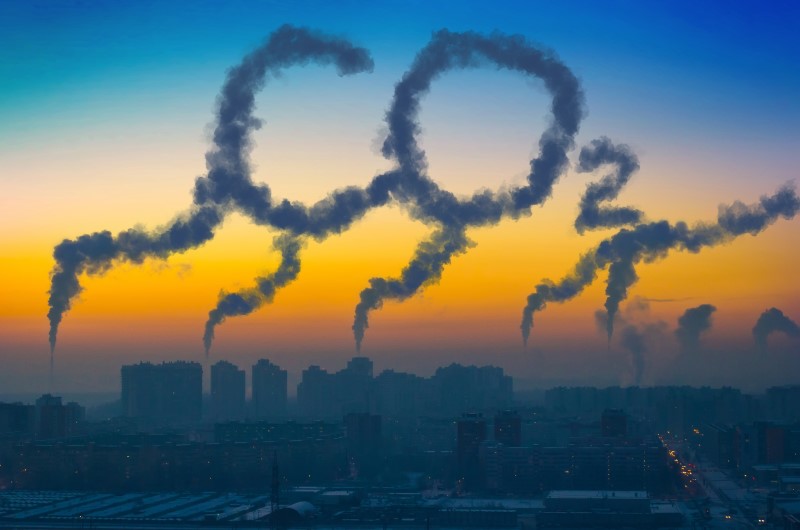Perspective: How Soon Could Carbon Capture Solve Industry CO₂ Shortages?
The Conversation via Reuters Connect
The recent spike in natural gas prices has closed many plants that make fertilizer in the UK – sending a shockwave through lots of other industries.

This is because ammonia fertilizers are made from nitrogen and hydrogen, and the latter comes from breaking down natural gas – a process which gives off carbon dioxide as a byproduct. It is this CO₂ that is then taken up and used in different industries, from carbonating soft drinks to euthanizing livestock. In its solid form, known as cardice, CO₂ can even be used to transport and store temperature-sensitive pharmaceuticals – including the Pfizer COVID-19 vaccine.
The scarcity of CO₂ has caused havoc in UK supply chains, threatening shortages of meat, alcohol and fizzy drinks.
It may seem surprising to read that CO₂ – the greenhouse gas heating our world – also keeps certain essential industries functioning. How can there be a shortage of something we’re desperately trying to emit less of? Couldn’t we just pull it down from the atmosphere and pump it into factories where it could be put to use?
The problem is that the CO₂ used in industry comes from sources that are a well-established part of a complex supply chain. This CO₂ generated in the process of making fertilizer is relatively cheap and easy to separate. If that system fails, there is no ready alternative. Meanwhile, CO₂ concentrations in the atmosphere are about 420 ppm – 0.0042% of all the gases. Separating CO₂ from the air is difficult, and far more expensive.
Something called “point-source carbon capture technology” is currently the best alternative option, and involves scrubbing CO₂ from exhaust gases in the chimneys of factories and power plants. Here, CO₂ is emitted in the highest volumes and concentrations are thousands of times higher than those found in the atmosphere.
Technologies which can capture carbon from power station chimneys or even directly from the air are being developed, but they aren’t available at the scale needed. Two UK-based competitions to drive innovation in carbon capture and storage technology have been launched and closed by successive governments since 2005, the last one ending in 2015 without much success.
Some initiatives have got off the ground though, including The Acorn Project in St Fergus, Scotland, which separates CO₂ from natural gas – which is used to make hydrogen – and injects it under the North Sea. The Drax C-Capture project, meanwhile, extracts CO₂ from emissions at a biomass energy plant in North Yorkshire, England. This project, it’s claimed, aims to be carbon-neutral in time by transporting the CO₂ via pipeline to an offshore storage site.
Ten years of research and engineering are usually needed before any new carbon capture technology can be deployed at the necessary scale. Industries which use CO₂ must plan for new carbon capture technology being available many years in the future, rather than expect immediate solutions.
And carbon capture units currently operating at selected locations globally, such as at the Boundary Dam coal-fired power station in Canada, are unlikely to offer the solution to CO₂ supply industries need. That’s because they use liquids to absorb and purify the greenhouse gas at high temperatures, which produces over 99% pure CO₂, but requires a lot of energy and so is expensive. Liquid adsorbents decompose at high temperatures too, leaving toxic byproducts.
Solid adsorbents, like those made from silica or cellulose powders, are much more stable. Some new systems use solid absorbents and high pressures rather than high temperatures to adsorb the CO₂. These are likely to be the cheapest to run and the least environmentally damaging, making them a good choice for industries to source sustainable CO₂. There are plans to install a pressure-based capture facility at Tata Steel plant in South Wales that will capture waste CO₂ and convert it into transport fuels.
In the next 30 years, industries will also need to consider direct air capture – technology capable of pulling the greenhouse gas out of the air – as a source of CO₂, but this will come at a cost to the consumer. Products that are made in processes requiring CO₂, such as carbonated drinks and fresh and packaged food, will have to pass on these cost increases.
Captured CO₂ should be stored in industrial reserves – steel tanks on the same site as the power plant the CO₂ came from or the factory where it might be used, and not underground. Industrial reserves need to be readily accessible as a backup supply.
Given that all these technologies are some way off being rolled out widely, society runs the risk of regular shortages without monitoring committees, similar to the COVID-19 task force, that can provide workable scenarios as soon as a problem occurs, rather than days or weeks into potential supply crises.
Related News
Related News

- Kinder Morgan Proposes 290-Mile Gas Pipeline Expansion Spanning Three States
- Enbridge Plans 86-Mile Pipeline Expansion, Bringing 850 Workers to Northern B.C.
- Three Killed, Two Injured in Accident at LNG Construction Site in Texas
- Tallgrass to Build New Permian-to-Rockies Pipeline, Targets 2028 Startup with 2.4 Bcf Capacity
- TC Energy Approves $900 Million Northwoods Pipeline Expansion for U.S. Midwest
- A Systematic Approach To Ensuring Pipeline Integrity
- U.S. Pipeline Expansion to Add 99 Bcf/d, Mostly for LNG Export, Report Finds
- Enbridge Adds Turboexpanders at Pipeline Sites to Power Data Centers in Canada, Pennsylvania
- Great Basin Gas Expansion Draws Strong Shipper Demand in Northern Nevada
- Cheniere Seeks FERC Approval to Expand Sabine Pass LNG Facility




Comments